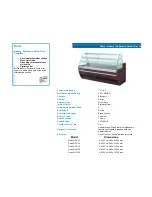Reviews:
No comments
Related manuals for PRIMUS 1000

CDF2001
Brand: Anvil Pages: 6

TMA44
Brand: trig Pages: 20

DENSEI MACHIDA FB-R5F11PLG
Brand: Naito Pages: 5

DULCE DCG 10
Brand: VALERA Pages: 2

GPSMAP 400 series
Brand: Garmin Pages: 76

C3URHP
Brand: Igloo Pages: 14

DL3M
Brand: Showcases Direct Pages: 7

Pi Touch Pro
Brand: Smarti Pages: 11

MCF-6C
Brand: KoolMore Pages: 5

SCDC-7T
Brand: KoolMore Pages: 11

















